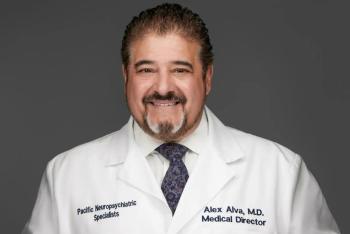
Telepsychiatry Basics: Setup, Sessions, and Pros and Cons
Telehealth is here, and it’s here to stay. A telepsychiatrist gives a brief description of the setup from his home office.
In the small, rural Veterans Administration clinic, where I worked part-time for 9 years, a nurse could use an otoscope to peer into the ear of a patient, and an ear, nose, and throat specialist could see remotely into the same patient’s eardrum from a 70-mile distance. A nurse could focus a camera on a skin lesion, and a dermatologist could examine the lesion clearly from a second location and interact with the patient in real time. Similarly, in my
As a practicing, full-time telepsychiatrist, a brief description of my setup from home may be of interest.
The equipment
I am using VA-supplied equipment that consists of a laptop computer running two monitors. The laptop stays closed, and I have a monitor directly in front of me that displays the patient (and a small frame on the edge that shows me, as the patient sees me) and a monitor to my left that displays the electronic medical record. I also use instant messaging (IM) software, which allows me to communicate via text messages with the staff at the “Far End” (that is, the end where the patient is sitting; by contrast, I am at the “Near End.”) The monitors are standard equipment available at any computer store-a quick Internet search shows them to be available for less than $200 each.
The computer uses Windows 7, and an Intel® i5 - 2520M CPU @ 2.50 GHZ chip, with 4 MB of RAM. For those of you who are technologically savvy, you will recognize that this is a pretty standard, mid-priced laptop. The laptop sits in a computer dock that allows it to run both monitors, and a small Logitech® HD C920 Pro Webcam camera sits on top of the central monitor. The laptop is wired via an ethernet cord to my router; I upgraded to a $200 router when I started practicing telehealth, but that probably was not necessary-the router supplied by my cable company likely would have worked fine.
I chose to use an ethernet connection instead of my home wireless network because of advice I received that the speed and quality of the video would be higher. My home Internet service is the standard cable connection available through my local provider, with no special upgrades. The equipment is running Cisco® Jabber video software for video conferencing, which Cisco lists as being HIPAA-compliant. [The preceding is not intended as an endorsement.]
The quality of the video on my system is only fair, largely because of restrictions on bandwidth for a user accessing the VA computer network. There are times when there is some distortion of the picture, especially if someone moves quickly. However, this is not a critical issue. As my telepsychiatry colleague and friend, Jeff Zigun, MD, points out, the video is a nice extra touch, but the ability to communicate by voice is the critical issue. For unknown reasons, the video during my first telepsychiatry session was not working, and I had to conduct the interview by voice communication alone. It’s not ideal, but it worked.
Unless you are pretty technologically savvy, you will need ongoing IT support. In my situation, the VA has excellent support, but it took well over 10 hours of consultation to make things work correctly and to work through all the issues of how I would communicate with staff and deal with patients. I have also required ongoing support to address problems that occurred while I was seeing patients, which means you need to have quick access to IT help and contingency plans in place if the problem cannot be quickly resolved. The problems have ranged from loss of video, (but intact audio), to a complete loss of the connection. (In fairness, I have been told that my system had far more problems than the average telehealth setup.)
The session
My patients seek treatment through the Veterans Health Administration Outpatient Clinic in Green Bay, Wisconsin. There, a trained technician lets me know via IM or telephone that my patient has arrived. She then greets the patient, brings the patient to the examination room, explains that I will be seeing them through an encrypted video system, and that the session is private and will not be taped. The technician then calls my video link, introduces me, and leaves the patient alone in the room.
The actual session is no different from an in-person evaluation, although I usually spend a minute or two making sure the patient is comfortable with the format. At the end of the appointment, I let the technician know we are done. She then comes to get the patient, makes the follow-up appointment, and takes care of any other business. We have an RN on site who can weigh the patient, take blood pressure, or handle other medical issues as needed.
As part of maintaining a safe environment for patient and staff, we have pre-established practices for various contingencies. We have protocols if the patient needs to be hospitalized, referred for immediate medical care, or other difficulties. I also have the contact information of clinic security staff and local law enforcement, if need be.
Pros and cons
Telepsychiatry offers patients
In my case, my primary goal in becoming a telepsychiatrist is my desire (heck, I grew up in Duluth, Minnesota-I have my cold weather bona fides! I will say need!) to escape the northern winters. I anticipate practicing from Wisconsin during the summer, and somewhere with lots of good sailing and warm weather in the winter. I think it is likely I will practice longer before retiring because I have this option.
Medical licensing and malpractice need to be explored before starting a telepsychiatry practice. In general, the medical encounter is felt to occur where the patient is-that is, the medical encounter is in Wisconsin if the patient is in Green Bay, even if the physician is in, say (just as an example) Florida. However, the issue of physical proximity is evolving, and a practitioner should clarify this matter both with the state medical board where the patient will be located as well as the state medical board where the physician is.
This concern also needs to be clarified with your malpractice carrier, including the question of which set of state statutes would apply if you were to become subject to a malpractice lawsuit. As an example, Wisconsin has a state-run Patient Compensation Fund that essentially protects the personal assets of physicians from malpractice settlements; in some states, personal assets are at risk in malpractice settlements. As Warren Buffett loves to say, most surprises in the area of insurance are of the unpleasant variety!
The greatest barriers to adapting to this technology are in our ways of thinking about telepsychiatry and our resistance to embracing new patterns of practice. The benefits for both the patient and the caregiver can be substantial-and as a result, perhaps more patients can be helped.
Disclosures:
Dr Knoedler left his “Comfort Zone” job as Medical Director of Sheboygan County Health and Human Services in Sheboygan, Wisconsin. He is now a full-time Telepsychiatrist for the VA Hospital in Green Bay, Wisconsin. He reports he has no conflicts of interest regarding the subject matter of this article, with the exception of possible shares of mutual fundsin some of the companies mentioned.
Newsletter
Receive trusted psychiatric news, expert analysis, and clinical insights — subscribe today to support your practice and your patients.

















